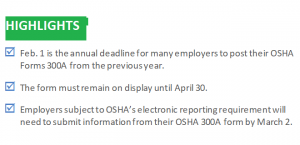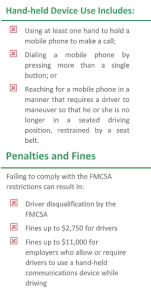
Workers’ Compensation Trends to Watch in 2021
Not only is workers’ compensation coverage required in most states, but it also plays a major role in connecting injured employees to the care they need to return to work as quickly and safely as possible. That’s why it’s crucial for your organization to develop an effective workers’ compensation program.
To ensure a successful program, it’s important to stay up to date on the latest workers’ compensation trends. In doing so, your organization will have the information needed to respond appropriately and make any necessary workers’ compensation program adjustments.
Don’t let your organization fall behind in this evolving risk landscape. Review the following guidance to learn more about workers’ compensation trends to watch in 2021.
The Effects of COVID-19
As the coronavirus pandemic continues, many employers have had to make a wide range of organizational adjustments—such as going remote, changing employees’ roles, implementing lay-offs or furloughs, or temporarily halting operations.
These adjustments, depending on which state you are in, could be subject to various workers’ compensation-related reporting changes, as well as potentially impact your organization’s premium costs and experience modification factor. This is because your workplace risks and safety exposures have likely changed due to such adjustments. Be sure to consult legal counsel for additional, state-specific guidance on the impact of such adjustments.
Your organization should also prepare for workers’ compensation claims related to COVID-19 exposure. Generally, in terms of COVID-19, claims are evaluated on a case-by-case basis, and coverage may be triggered if both of the following are true:
- The illness in question arises out of the course and scope of employment.
- The illness in question arises out of or is caused by job-specific conditions and not an ordinary disease of life (e.g., the common cold) to which the general public is exposed.
Keep in mind that every claim is different. When it comes to compensability, you’ll need to evaluate what jobs or tasks an employee was performing when they were exposed to COVID-19. Additionally, states are going to have different thresholds for COVID-19 compensability. Some states may have more general language regarding workplace illnesses, and communicable and contagious diseases in their statutes, while others have issued specific guidance on COVID-19 claims.
Specifically, a number of states have enacted legislation and issued executive orders that expand workers’ compensation coverage for certain employees (e.g., health care workers and first responders). In particular, some states have created new rules regarding COVID-19 presumptions. A presumption describes the conditions in which an employee’s injury or illness is presumed to have happened on the job and should be compensated. Be sure to track your specific state’s developments regarding the interaction between COVID-19 cases and workers’ compensation claims.
In any case, it’s important for your organization to implement workplace health and safety measures to help protect your staff from COVID-19 exposure and limit the likelihood of related claims. Further, review guidance from your state workers’ compensation board and speak with an insurance professional to learn more about how your coverage may or may not respond to COVID-19 claims.
The Adoption of Telemedicine
The coronavirus pandemic has certainly contributed to an acceleration in the adoption of telemedicine within the workers’ compensation realm. However, workplace health and safety experts anticipate that telemedicine will remain a key offering even after the pandemic subsides.
Telemedicine allows employees to receive medical services virtually after they’ve been injured on the job. Examples of telemedicine in action may include video consultations with care providers following an injury (allowing for a virtual evaluation and diagnosis) and text message alerts that remind the recovering employee of treatment steps or upcoming appointments.
Telemedicine can be useful in situations where medical care isn’t easily accessible to staff, such as:
- When an injury occurs during an overnight shift and most treatment facilities have closed
- If your workplace is located in an area where there are limited care facilities nearby
- If your organization frequently conducts work off-site—making care availability unpredictable
Telemedicine is also an increasingly viable option to help staff avoid the risks of in-person visits or having to navigate adjusted clinic schedules during the coronavirus pandemic.
In addition to providing employees with easy access to medical care following an injury, utilizing telemedicine can offer a variety of key benefits to your workers’ compensation program. This includes transportation and time savings by limiting physical trips to the doctor, simplified access to medical specialists and improved recovery capabilities for injured employees—minimizing treatment delays.
Further, the combination of these benefits can, in turn, help reduce your organization’s overall workers’ compensation claim costs—limiting the need for in-person treatment while still ensuring quality care and a speedy recovery.
However, keep in mind that telemedicine is not a universal care solution for all workplace injuries. This offering only applies to non-urgent situations. In-person treatment will always be necessary in the event of an emergency. Even in non-urgent situations, telemedicine may still need to be combined with in-person treatment.
The Impact of Mega Claims
Another trend that has become a costly issue in the realm of workers’ compensation is the surge in mega claims. These are exceptionally large claims—totaling $3 million or more in incurred losses.
In regard to workers’ compensation, these claims typically stem from employees experiencing severe (and possibly permanent) injuries on the job. While the causes of these injuries vary, mega claims are usually attributed to falls, motor vehicle accidents and struck-by incidents. In some cases, however, mega claims can develop slowly—particularly when caused by minor injuries that go untreated.
Mega claims are not only expensive, but often lengthier and more complex in nature. Such claims can leave lasting impacts on your organization by way of hefty costs, lost time and the potential for severe reputational damage.
What’s more, mega claims have become a rising concern in the past decade. In fact, according to a recent study conducted by the National Council on Compensation Insurance (NCCI), these claims have reached a 12-year high—increasing in both frequency and severity. This increase has been attributed to several possible factors, such as changes in mortality patterns, medical advances and a rise in health care costs.
Despite their devastating impact, mega claims may be preventable in some instances. To combat such claims, it’s critical to ramp up your safety efforts—particularly when it comes to preventing falls, motor vehicle accidents and struck-by incidents.
The Rise in Comorbidities
The rising concern of comorbidities has also become a recent workers’ compensation trend. Put simply, a comorbidity is the simultaneous presence of two or more medical diagnoses for an individual.
Comorbid conditions are typically long-term health complications that have the potential to increase the severity of other injuries or illnesses that the affected individual may experience, making it more difficult to fully recover. Common comorbid conditions include obesity, diabetes, hypertension, depression, anxiety and substance abuse.
According to a study conducted by the NCCI, workers’ compensation claims involving comorbidities have nearly tripled since 2000. Further, the average cost of workers’ compensation claims connected to a comorbid condition is almost twice as much as that of comparable claims that don’t involve comorbidities.
This increase in workers’ compensation costs is likely tied to the often complex, long-term nature of claims that involve comorbidities. After all, individuals who have comorbid conditions typically take longer to heal from an injury, are more prone to develop additional complications due to an injury and are even at an increased risk of being left permanently disabled by an injury.
To combat the potential impact of comorbidities, many employers have found success by implementing wellness initiatives. In other words, if your organization takes the time to address chronic health conditions and improve the overall well-being of your staff, you could reduce the severity of workers’ compensation claims and maintain low comorbidity rates overall.
The Concern of Key Labor Trends
In recent years, filling jobs with experienced workers has been a challenge for organizations across industry lines due to ongoing labor shortages. As a result, many employers have begun hiring a larger number of inexperienced workers. However, such a practice comes with workers’ compensation risks.
In fact, according to a recent survey conducted by the Golden Triangle Business Roundtable in Texas, employees with less than five years of experience contribute to 43% of overall workplace injuries. This is likely because inexperienced workers often lack years of safety training and may be more willing to take unnecessary risks.
In addition to a rise in inexperienced employees, the past decade has also brought on an aging workforce. According to the U.S. Bureau of Labor Statistics, the share of employees over the age of 55 in the labor force is expected to increase to nearly 25% by 2024 (up from 21.7% in 2014). Such a statistic is notable, as the cost of workers’ compensation claims generally increases as employees age. After all, because health typically diminishes with age, the impact of minor injuries can be more severe for older workers—taking them longer to fully recover.
Furthermore, age-related changes and declines can include a shorter memory, slower reaction times, a decline in vision and hearing, or a poor sense of balance. These limitations can lead to many injuries for older workers, including falls caused by poor vision or a slowed reaction time, sprains and strains due to a loss of strength or balance, and injuries from repetitive tasks.
These trends emphasize how crucial it is for your organization to promote a safe working culture and prioritize injury prevention. Specifically, be sure to conduct routine safety training for all employees and implement effective workplace safety policies.
The Results of Marijuana Legalization
Following the 2020 election results, medical marijuana is now legal in 36 states, and recreational marijuana is now legal in 15 states. In response, your organization will need to review changes to your state’s legislation (if any) and adjust your workers’ compensation program accordingly.
In terms of medical marijuana, very few prescription drugs that are approved by the U.S. Food and Drug Administration (FDA) and contain marijuana exist on the market. And because doctors are only permitted to prescribe FDA-approved drugs, the actual prescription of medical marijuana for treatment is rare. That being said, if your state has legalized medical marijuana, it is best to consult legal counsel to ensure that your workers’ compensation program supports compliant treatment options.
In regard to recreational marijuana, it should be treated similarly to alcohol usage in the workplace. That is, it should be prohibited during work hours, as it can hinder employees’ abilities to perform tasks safely and increase the likelihood of injuries—contributing to workers’ compensation claims.
We’re Here to Help
You don’t have to respond to this changing risk landscape alone. We’re here to help you navigate these trends with ease. For additional workers’ compensation resources, risk management guidance and insurance solutions, contact us today.








